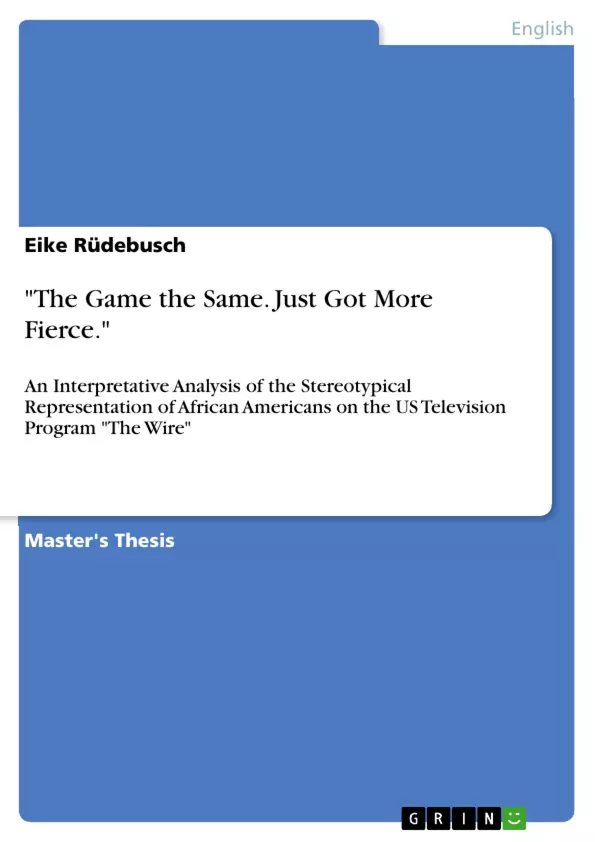The Wire, David Simon's and Ed Burns' HBO show about the war on drugs in Baltimore and the de-industrialized American economy, has been praised by critics, authors and scholars. It was called the “best show since the invention of radio” (Brooker as quoted by Toscano) and compared to 19th century classical literature of Balzac, Dickens and others, and even Barack Obama named the show to be his favorite.
The Wire was broadcast between 2002 and 2008 and thus is part of the cultural representation of the years before Obama became the first African American president of the United States of America. That might seem to be just a chronological fact on the sideline, but can be considered quite important instead. That is, because media mirrors a society's development and its recent state of mind. With Obama in office, it might seem that America has had a significant change of mind in terms of its conduct toward African Americans. The Wire was widely praised to be a multicultural show, if not even a post-ethnic show, that avoided all forms of negative, stereotypical depictions of Blacks and included Blacks in numbers never seen before on TV.
Until today, the representation of Blacks in the media is something academics and journalists, political activists and authors write and discuss about. It is stained by the American past of slavery and segregation. Certain stereotypes and prejudices about Blacks have endured time and can be found in American society, among all races and all classes. However, The Wire with its huge number of Black characters along with their quality and depth, is seen as an exception from the usual TV program. The show was praised for its politics of representation, for putting Black characters in a drama, for including them in all depicted classes, all levels of hierarchies – Blacks are part of the street, the law, politics, the harbor, the media (Buehler 55) – and for the sheer range of Black roles that was said to make stereotyping nearly impossible (Morsch 216).
[...] However, this thesis will prove that David Simon's monumental 60-hour-long show may be an exceptional TV show but nevertheless works with long-known and well-established schemes of representation and stereotypes of African Americans. The praise it has received will be made understandable on one hand, but will be shown as incomplete and ignorant on the other.
Inhaltsverzeichnis (Table of Contents)
- Introduction
- Theoretical Background
- Representation and Discourse
- Stereotypes
- Origin of the term
- The Definition and History of the Concept
- Stereotypes in the Media
- Race
- Race as the Basis for Stereotyping
- The Changing Depictions of Blacks in the U.S.
- Depictions of Blacks in Cinema and on Television
- Stereotypes of African Americans today
- African Americans on TV in the 21st Century
- The Wire
- Analysis in Regards to Representation and Stereotypes
- The Simultaneity of Transformation and Recurrence
- Transformation of Stereotypes in The Wire
- Discursive Practices of Representation
- Changes in the Representations of Blacks
- Character Analysis with Regards to Changed Stereotypes
- Recurrence of Stereotypes on The Wire
- Reappearance of Stereotypical Representation of Blacks
- Character Analysis with Regards to Reappearing Stereotypes
- Uncle Toms and Coons
- Brutal Black Bucks
- Conclusion
- Works Cited
Zielsetzung und Themenschwerpunkte (Objectives and Key Themes)
This thesis aims to analyze the representation of African Americans in the HBO show "The Wire" and to determine whether the show has truly broken free from stereotypical depictions of Blacks. The main objective is to understand the interplay between transformation and recurrence of stereotypes in the context of "The Wire" and its portrayal of African American characters. Key themes explored in the thesis include:- The impact of race and racism on media representations of African Americans.
- The evolution of stereotypes and their persistence in contemporary media.
- The role of "The Wire" in challenging and perpetuating stereotypes about African Americans.
- The significance of representation and its influence on societal perceptions.
- The complex interplay between social, cultural, and economic factors in shaping media representations.
Zusammenfassung der Kapitel (Chapter Summaries)
- Introduction: This chapter introduces the thesis's central argument, highlighting the critical acclaim "The Wire" has received for its portrayal of African Americans. It raises the question of whether the show truly overcomes stereotypical representation or if it simply recontextualizes them.
- Theoretical Background: This chapter defines the terms "representation" and "discourse" and explains their relevance to the study of stereotypes in media.
- Stereotypes: This chapter delves into the history and definition of stereotypes, focusing on their application within media, particularly in the United States.
- Race: This chapter examines the role of race as a fundamental basis for stereotyping, highlighting the historical and social context of racial prejudice in America.
- The Changing Depictions of Blacks in the U.S.: This chapter traces the evolution of Black representation in American cinema and television, exploring how stereotypes have evolved and persisted over time. It also examines the representation of African Americans in the 21st century and explores psychological research on prejudices and stereotypes.
- The Wire: This chapter introduces "The Wire" as a narrative, highlighting its themes and topics. It places the show within the framework of African American media representation as defined by Herman Gray.
- Analysis in Regards to Representation and Stereotypes: This chapter explores the interplay between transformation and recurrence of stereotypes in "The Wire." It analyzes the show's depiction of African Americans in relation to the criteria outlined by Frank Kelleter and Donald Bogle.
Schlüsselwörter (Keywords)
This thesis focuses on the critical examination of stereotypical representation of African Americans in television, specifically analyzing "The Wire." Key terms and concepts include: representation, discourse, stereotypes, racism, African American representation, media, "The Wire," transformation, recurrence, and character analysis.- Citation du texte
- Eike Rüdebusch (Auteur), 2014, "The Game the Same. Just Got More Fierce.", Munich, GRIN Verlag, https://www.grin.com/document/279717



